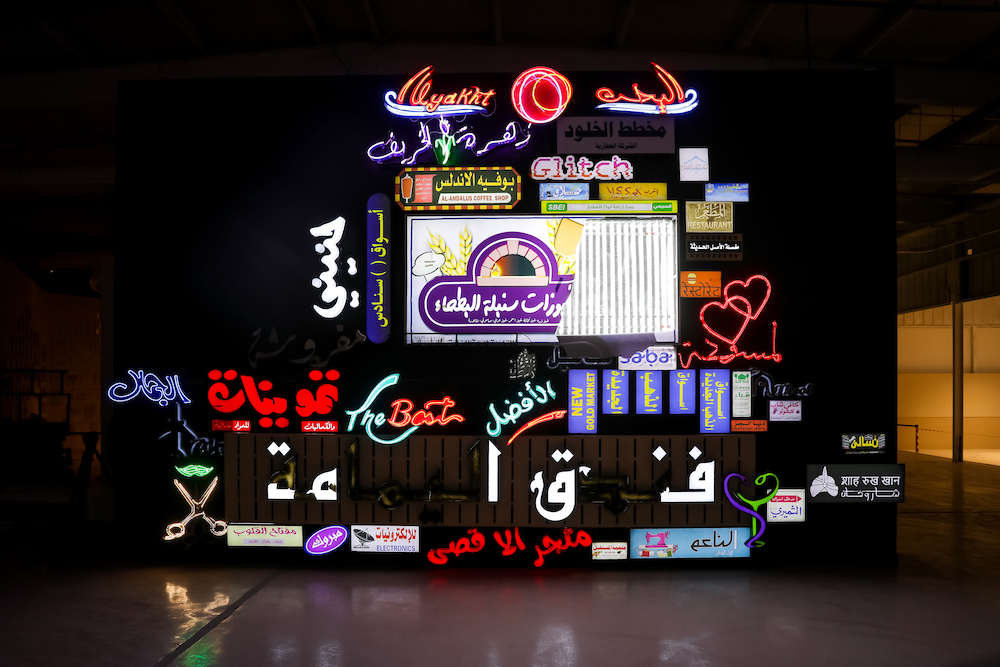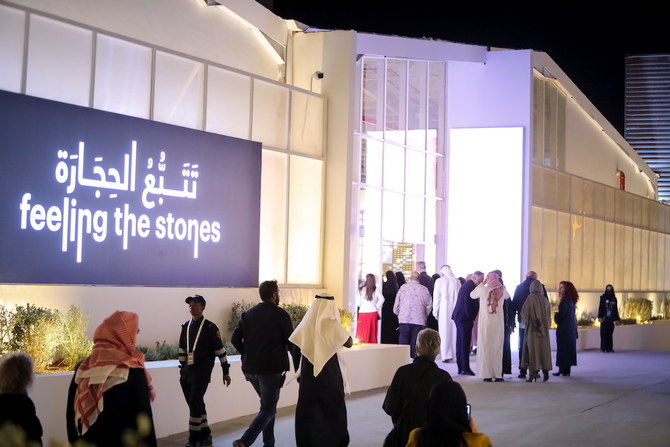On the evening of Dec. 10, about 300 guests from Saudi Arabia and abroad congregated just outside of the Diriyah Biennale Foundation in JAX, a new creative district in an industrial area of Riyadh’s historic Diriyah district, for the opening of the Diriyah Contemporary Art Biennale — a historic moment for Saudi Arabia, and one that marked the first time that the Kingdom has ever hosted a biennale dedicated to contemporary art.
The crowd was silent as they listened to an emotive opening speech by Philip Tinari, curator of the biennale and also director and CEO of the UCCA Center for Contemporary Art in China. The biennale’s title, Crossing the River by Feeling the Stones, stems from a Chinese saying signaling the attitude towards China’s reform and opening to the world that began in 1978 — a popular metaphor Chinese leaders use to describe the path they have taken following economic reform. Tinari used it to also refer to Saudi Arabia’s present moment of cultural and social change.

Curator of the Diriyah Contemporary Art Biennale, Philip Tinari, Director and Chief Executive of UCCA.
“As we were preparing this biennale, this slogan spoke to me on two levels, first for its relevance in Saudi Arabia today, where we are privileged to witness a similar moment of dynamism, optimism and openness, and with it, transformative change,” Tinari said.
The biennale, which opened to the public officially on Dec.1 1 and will run until March 11 next year, is situated throughout the newly converted warehouses in the JAX district. It unfolds in six sections, featuring works by about 64 artists from around the world with a focus on 27 Saudi artists.
The Diriyah Biennal Foundation commissioned 29 new works for the show.
The six sections explore the sub-themes of the spiritual in art, environmental heritage and conservation, gender issues, the effects of the COVID-19 pandemic and community building. Dialogue through culture is one of the aims of the nonprofit Diriyah Contemporary Art Biennale, which was established in 2020 with support from the Saudi Ministry of Culture.
“Having non-commercial spaces in Saudi Arabia is extremely important as it generates very different kinds of art,” artist Dana Awartani told Arab News. “For a long time, the artists here were used to showing in a gallery setting or partaking in art fairs. For me, the work you create in a biennale is the highest level of art, because you are able to experiment and push the boundaries of what you want to do without thinking of creating something that is for sale.”

Installation view, Diriyah Contemporary Art Biennale 2021.
Awartani’s breathtaking 23.7 x 13.5-meter clay earth work, titled “Standing in the Ruins of Aleppo (2021),” takes the form of a long-tiled floor and engages with the theme of cultural destruction through the subject of the Grand Mosque of Aleppo, prompting guests to think about the effects of cultural destruction on society.
“A biennale is about cross-cultural dialogue,” she added. “You learn from your peers and for me that is one of the most exciting things about being in a biennale, and it is so important we have one in Saudi Arabia.”
The artists and curators will tell you that an exhibition of this kind has long been awaited in the Kingdom.
“I am really hoping that this will be a turning point for these individuals and for the scene in general, as we are now able to put these incredible Saudi artists into global dialogue on their home turf and on equal terms with the rest of the world,” co-curator Wejdan Reda told Arab News.
The exhibition opens with two powerful works placed side by side: US artist Richard Long’s “Red Earth Circle,” created during the 1980s for a show in Paris that dubbed itself as the first global contemporary art exhibition, and Saudi artist Maha Malluh’s “World Map” from her “Food for Thought (2021) series,” which incorporates 3,840 cassette tapes to depict a map of the globe. “Good art,” says Malluh, “forces you to pause, to contemplate and to think harder about your surroundings.” The works in this series, which form images and Arabic letters, do exactly this. Around the corner are several vintage cathode-ray TV sets playing an animated archive of photographs from “Saudi Arabia in Prognosis (desert meeting) (2021)” by Saudi artist Ahmed Mater.

Maha Malluh, Food for Thought “WORLD MAP”, 2021.
In the first section are works by an older generation of Saudi artists showcasing the roots of the present Saudi art scene that has blossomed thanks to numerous government initiatives. On show is a collection of works from the 2000s from the Al-Mansouria Foundation, which reveals works on canvas made by artists such as Fahad Al-Hejailan, Jowhara Al-Saud, Munira Mosli and Ayman Yossri Daydban.
The art in this biennale prompts the visitor to question the social and artistic characteristics common to moments of epochal change. Can there be an aesthetics of reform? The common spirit of urgency found in the works on show — despite their diverse aesthetics and chosen mediums — seems to suggest that there might be, especially as a culture is on the brink of great change.
What unfolds throughout the exhibition’s winding halls and multitudinous spaces are multi-disciplinary works by artists from Saudi Arabia, the Middle East and beyond, placed in dialogue as they seem to call out in unison almost urgently to be seen and heard. Elsewhere in the first section, works explore ideas of urban transformation, economic history, social structures and progression. One such work is a powerful video installation, “Sakura,” by renowned US artist Sarah Morris. It captures historical moments and places, from the 2008 Beijing Olympics, the frenzy of downtown Manhattan to the cultural and industrial landscape of Rio de Janeiro.
There is also the late Moroccan artist’s Mohamed Melehi’s vibrant paintings of abstract forms; South African William Kentridge’s eight-channel video installation “More Sweetly Play the Dance (2015),” depicting a never-ending joyful procession of dancers and musicians from the beginning to end of the installation; Saudi artist Dania Al-Saleh’s installation “That Which Remains (2021),” investigating the disappearance and preservation of cultural memory in the face of globalization through depictions of old footage and images from Saudi Arabia; the paintings from Egyptian artist Ibrahim El Dessouki’s “Series of Gated Communities,” as well as Saudi artist Filwa Nazer’s “Five Women,” a group of sculptural works made in textile and haberdashery exploring themes of transition and memory by deconstructing the designs of traditional Arabic female dresses.

‘Five Women’, by the Saudi Artist Filwa Nazer.
It would be hard not to take note of the powerful works by 12 Chinese artists on show interspersed throughout the exhibition. They exemplify the parallels between China’s moment of reform during the 1980s and Saudi Arabia’s rapidly sweeping socio-economic changes being instituted largely under Vision 2030.
“I live and work in Beijing and run a place called UCCA Center for Contemporary Art,” Tinari told Arab News. “For the last 10 years I have done a lot of academic and curatorial research on the Chinese avant-garde. I saw some parallels between where Saudi is today and where China has been in terms of opening to the world, culturally speaking.”
Simon Denny’s “Real Mass Entrepreneurship (2017-2021),” for example, reveals an installation that fills the entirety of one room. It explores the changes taking place in the southern Chinese city of Shenzhen since the establishment of the Shenzhen Special Economic Zone in 1980 and how the city served as linchpin for China’s economic reforms — a transformative process that coincided with the growth of contemporary art in the country.

Installation view, Diriyah Contemporary Art Biennale 2021.
One two-channel video work by Lei Lei & Chai Mi, titled “1993-1994 (2021),” commissioned by the Diriyah Biennale Foundation, was inspired by the accidental discovery of a family archive. Much of the footage was shot by Chai’s father, who worked in the UAE for seven years in the 1990s. Decades ago, Chai’s father documented his daily life in the Gulf with a video cassette against the background of Cantonese pop music.
Among the Saudi contingent of artists are notable works by Sultan bin Fahad, titled “Dream Traveled (2021).” It reveals a startlingly beautifu tented room made of colored beads depicting Hajj murals and images from the Holy Qur’an. There is also Sarah Ibrahim’s “Soft Machines (2021),” a video installation investigating the human body as a vessel of memory, a site of transformation and a vehicle of communication and ultimately, a place where one and the collective can transcend. Abdullah Al-Othman’s joyful installation “Manifesto: The Language & City (2021)” reveals a pulsating large-scale work made in neon, LED and found wooden signage to recreate the street signs of Riyadh, where the artist condenses the city into a visual, cultural and architectural language.

Abdullah Al Othman, Manifesto, The Language & City.
Conceptual artist Muhannad Shono’s eerie yet captivating “On Losing Meaning (2021)” presents a programmable robot covered in petroleum jelly and pigment tips, creating an abstract form as it moves across the floor. “As a child, my imagination was everything, an escape, and a way to reshape the environment around me,” he said in a statement. “By creating narratives and drawing characters, I could make the world as I wanted to see it.”
The last section, Concerning the Spiritual, seems to suggest that social and cultural reform might possibly be met with a mindset that transcends the earthly realm. The works in this section are light-infused, ethereal structures, most notably the large blue glass sculpture by Larry Bell called “Iceberg (2020).” It transports the viewer outside of his or her own reality towards something greater — towards the idea of the infinite. The first edition of Saudi Arabia’s first contemporary art biennale thus concludes with an exploration into how no matter what problems the world faces, art can uplift, transcend and transport us to something greater than ourselves.






























